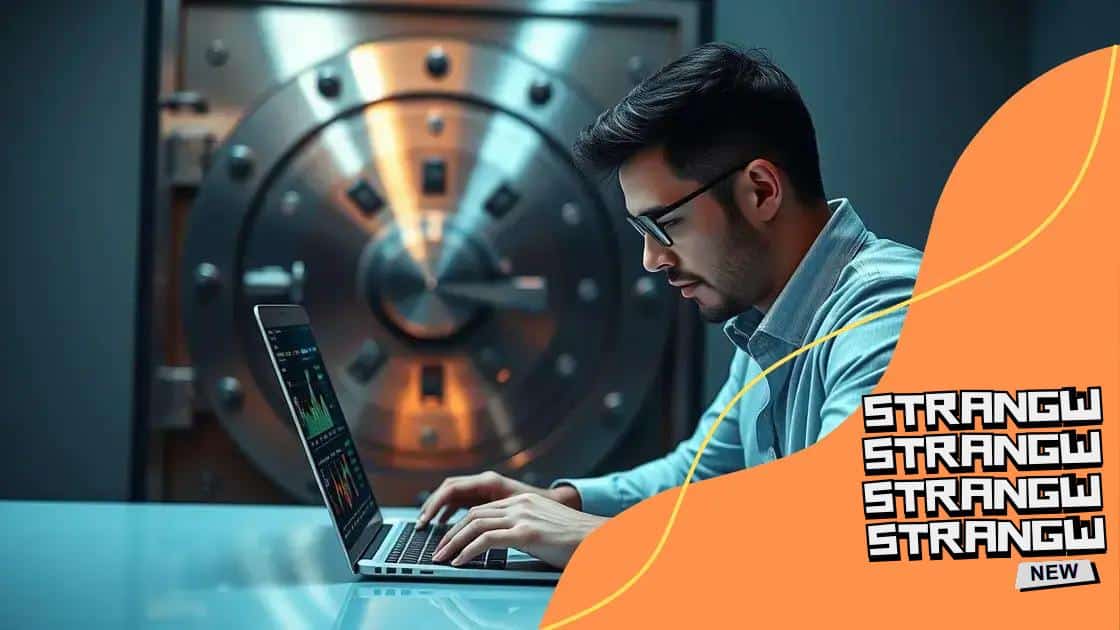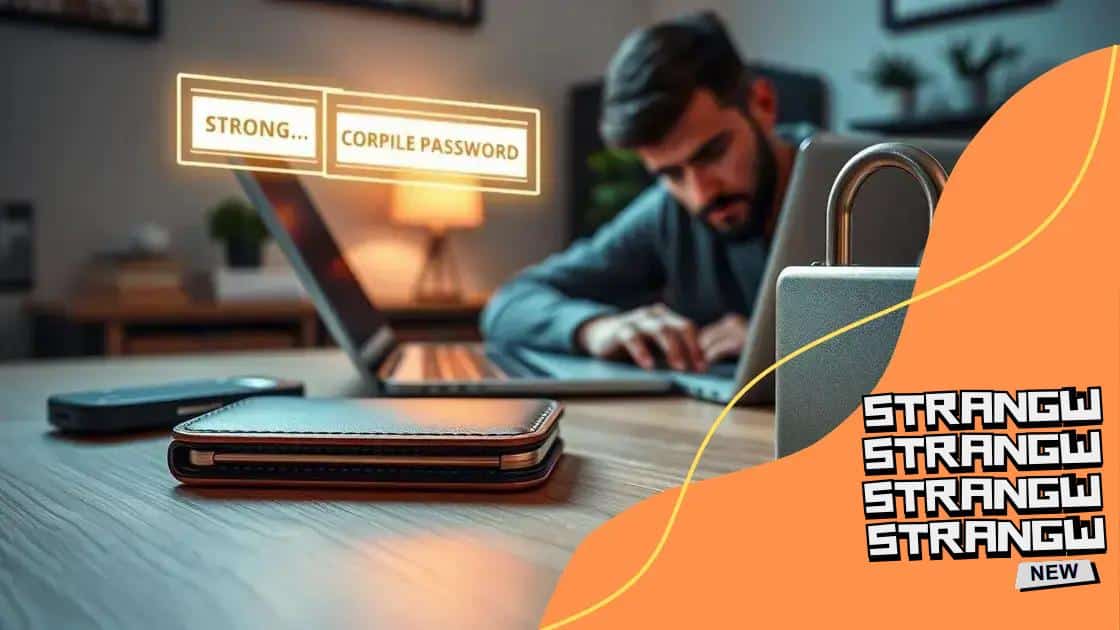Cryptocurrency security best practices to safeguard your assets

Understanding cryptocurrency security best practices is crucial for protecting your investments, focusing on using strong passwords, enabling two-factor authentication, recognizing scams, and employing secure wallets.
Cryptocurrency security best practices are crucial for anyone investing in digital currencies today. Have you considered how safe your investments really are? Let’s dive deeper into effective strategies you can adopt.
Understanding cryptocurrency security threats
Understanding cryptocurrency security threats is vital for anyone in the digital currency space. With the rise of cryptocurrencies, new risks have emerged. Being aware of these threats can help you protect your assets effectively.
Types of Threats
Cryptocurrency users face several types of security threats. The most common include:
- Phishing attacks: These are attempts to trick you into giving up sensitive information. Always verify the source of emails or messages.
- Malware: Some attackers use malicious software to access your devices and steal your private keys.
- Ransomware: This type of malware locks your files until you pay a ransom, often in cryptocurrency.
- Exchange hacks: Centralized exchanges are popular targets. Keeping your assets in a secure wallet is crucial.
Each of these threats poses a significant risk. To minimize exposure, it’s essential to stay informed and take precautions. For instance, using hardware wallets can prevent unauthorized access to your coins. Regular updates to your software can also keep your systems secure, making it harder for attackers to exploit vulnerabilities.
Another crucial step is to implement strong passwords and enable two-factor authentication (2FA) wherever possible. These actions add another layer of protection, helping you secure your accounts from unauthorized access. Regularly reviewing your security practices is key, as the landscape of threats is always evolving.
How to Stay Secure
By understanding these common threats, you can be proactive about your security. Make sure to educate yourself about the latest scams and tactics used by cybercriminals. Additionally, developing a habit of scrutinizing links and attachments will further safeguard your assets.
Remember, your vigilance is crucial in maintaining the security of your cryptocurrency investments. By being informed and prepared, you can enjoy the benefits of cryptocurrency with peace of mind.
Essential tools for securing your crypto assets
When it comes to protecting your digital investments, using the right tools is essential. There are several essential tools for securing your crypto assets that can help you stay safe in the volatile market.
Hardware Wallets
One of the best protective measures is a hardware wallet. These devices store your private keys offline, making them less vulnerable to hacks and malware. Popular options include:
- Trezor
- Ledger Nano S
- Ledger Nano X
By utilizing a hardware wallet, you add an extra layer of security that keeps your cryptocurrencies safe from online threats.
Software Wallets
In addition to hardware wallets, software wallets are also commonly used. While they are more convenient for everyday transactions, they require careful management. Always choose reputable wallets and consider features like:
- Multi-signature capability
- Regular updates
- Strong password options
These features help mitigate risks while providing flexibility for your trading needs.
Another vital tool is a password manager. Using a password manager can help you create and store complex passwords securely. This is crucial because strong passwords protect your wallet and exchange accounts from unauthorized access.
Moreover, operational tools like VPNs provide additional encryption for your internet connection. By using a VPN, you can mask your IP address and encrypt data transfers, which greatly reduces the risk of eavesdropping by malicious actors.
Two-Factor Authentication
Always enable two-factor authentication (2FA) for your accounts. This feature adds a second layer of security by requiring a second form of identification. Many exchanges offer 2FA. It significantly decreases the chances of unauthorized access.
In summary, combining hardware wallets, software wallets, password managers, VPNs, and 2FA creates a robust security system for your cryptocurrency investments. By employing these essential tools, you minimize risks and secure your digital asset holdings effectively.
Best practices for wallet safety

Ensuring wallet safety is critical in the world of cryptocurrency. Adopting the best practices for wallet safety can help protect your assets from theft and loss.
Use Hardware Wallets
One of the safest options is to use a hardware wallet. These devices store your private keys offline, reducing the risk of online attacks. By keeping your keys secure, you protect your digital holdings effectively.
- Choose reputable brands like Trezor or Ledger.
- Always buy directly from the manufacturer to avoid tampered devices.
- Keep firmware updated to defend against vulnerabilities.
In addition, you should always backup your wallet. Creating a backup ensures you can recover your funds in case your hardware wallet malfunctions or is lost. This backup should be kept in a safe, secure location.
Utilize Strong Passwords
Another best practice is to utilize strong passwords for your wallet accounts. Strong, unique passwords are essential for keeping hackers out. Consider using a password manager to help generate and store these passwords safely.
- Avoid using easily guessed passwords like birthdays or names.
- Change your passwords regularly to enhance security.
- Enable two-factor authentication to add another layer of protection.
By combining strong passwords with other security measures, you significantly reduce your vulnerabilities.
Be cautious about sharing your wallet details. Never disclose your private keys or seed phrases, as these contain access to your funds. Educate yourself about phishing attacks, which can trick you into revealing sensitive information. If you receive unexpected requests for your wallet information, do not respond.
Regular Monitoring
Lastly, regularly monitor your wallet and transaction history. Being aware of unusual activity can help you react promptly to potential threats. Setting up alerts can also help notify you of significant changes or access attempts.
By implementing these best practices for wallet safety, you create a robust defense against the many risks in the cryptocurrency landscape. Staying proactive and informed is key to ensuring the security of your digital assets.
Importance of two-factor authentication
The importance of two-factor authentication (2FA) cannot be overstated in the world of cryptocurrency. This security measure significantly enhances the protection of your accounts and assets.
What is Two-Factor Authentication?
Two-factor authentication is an extra step that requires not only your password but also a second piece of information to access your account. This second factor often comes from something you have, such as a smartphone or a hardware token. By adding this layer, you make it much harder for unauthorized users to gain access.
Benefits of 2FA
Utilizing 2FA comes with several key advantages. First, it greatly reduces the risk of hacking. Without the second factor, a simple password breach won’t grant access to your accounts. Second, 2FA can deter potential attackers, as the additional security makes your account less appealing to target.
- Increased security: By requiring two forms of identification, you enhance the safety of your cryptocurrency.
- Fewer successful phishing attempts: Even if someone captures your password, they still need the second authentication factor.
- Peace of mind: Knowing your accounts are safer allows you to focus on trading and investing without constant worry.
Several forms of two-factor authentication are available. SMS codes are common, where a text message is sent to your registered number. However, relying on SMS can be less secure due to potential interception. An increasingly popular option is the use of an authenticator app. These apps generate time-sensitive codes that are more secure than SMS messages.
Setting Up 2FA
Many exchanges and wallet providers offer the option to enable 2FA. Setting it up is typically straightforward. First, navigate to the security settings of your account. Next, follow the prompts to activate 2FA, choosing your preferred method—be it an SMS code or an authenticator app. Remember to save backup codes provided during the setup process; these can help you regain access if you lose your device.
In conclusion, implementing two-factor authentication is one of the simplest and most effective methods to protect your cryptocurrency assets. By taking this step, you significantly lower the chances of losing your investments due to hacks and unauthorized access.
How to recognize and avoid scams
Recognizing and avoiding scams is crucial in the cryptocurrency space. With its rapid growth, many fraudsters target unsuspecting users. By being informed, you can protect your investments and personal information.
Common Types of Scams
There are various scams that you should be aware of to safeguard yourself effectively. Some common scams include:
- Phishing scams: Fraudsters often send fake emails that look legitimate, tricking users into revealing their private keys or passwords.
- Ponzi schemes: These investment scams promise high returns with little risk, encouraging users to invest without understanding how their money will be used.
- Fake exchanges: Some websites mimic real exchanges to steal funds or personal information from users.
Understanding these types of scams is the first step in protecting yourself. Always verify the source of any communication you receive regarding cryptocurrency.
Red Flags to Watch For
There are specific red flags that can help you identify potential scams. Be cautious if you notice:
- Unsolicited offers: Be wary of unexpected messages promising guaranteed returns.
- Pressure tactics: Scammers often create a sense of urgency to push you into making hasty decisions.
- Too good to be true: If an investment opportunity sounds too good to be true, it probably is.
Additionally, ensure you check the credibility of any platform or individual before engaging in transactions. Always look up reviews and research the history of exchanges or wallets you plan to use.
How to Protect Yourself
To avoid falling victim to scams, follow these protective measures. First, enable two-factor authentication on your accounts for added security. Second, keep your software and wallets updated to protect against vulnerabilities. Finally, never share your private keys or passwords with anyone. No legitimate service will ask you for this information.
When in doubt, consult reliable sources or forums to verify information before taking any actions with your cryptocurrency. Your safety largely depends on your caution and due diligence.
In conclusion, staying safe in the cryptocurrency world is essential for protecting your investments. By understanding the importance of strong security measures, such as two-factor authentication and recognizing scams, you can defend yourself from potential threats. Make it a habit to use hardware wallets, keep your software updated, and monitor your accounts regularly. Remember, knowledge is power, and remaining aware of the risks and tools available will help you navigate the dynamic landscape of cryptocurrency with confidence. Always prioritize safety as you invest and trade in this exciting market.
FAQ – Frequently Asked Questions about Cryptocurrency Security
What is two-factor authentication, and why is it important?
Two-factor authentication is a security measure that requires two forms of identification to access your account, greatly enhancing your protection against unauthorized access.
How can I recognize cryptocurrency scams?
Common scams include phishing emails, Ponzi schemes, and fake exchanges. Look for unsolicited offers and promises that sound too good to be true.
What are the best practices for securing my cryptocurrency wallet?
Use hardware wallets, enable two-factor authentication, create strong passwords, and regularly update your software to keep your wallet safe.
Why is it necessary to monitor my cryptocurrency accounts?
Regularly monitoring your accounts helps you spot any unusual activity quickly, allowing you to react immediately to potential threats.





